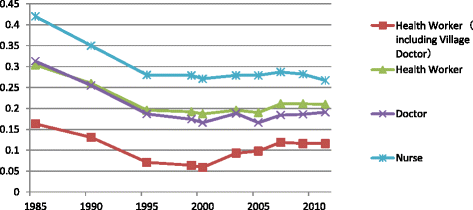Inequality trends of health workforce in different stages of medical system reform (1985-2011) in China
- PMID: 26645960
- PMCID: PMC4673776
- DOI: 10.1186/s12960-015-0089-0
Inequality trends of health workforce in different stages of medical system reform (1985-2011) in China
Abstract
Introduction: The aim of this study was to identify whether policies in different stages of medical system reform had been effective in decreasing inequalities and increasing the density of health workers in rural areas in China between 1985 and 2011.
Methods: With data from China Health Statistics Yearbooks from 2004 to 2012, we measured the Gini coefficient and the Theil L index across the urban and rural areas from 1985 to 2011 to investigate changes in inequalities in the distributions of health workers, doctors, and nurses by states, regions, and urban-rural stratum and account for the sources of inequalities.
Results: We found that the overall inequalities in the distribution of health workers decreased to the lowest in 2000, then increased gently until 2011. Nurses were the most unequally distributed between urban-rural districts among health workers. Most of the overall inequalities in the distribution of health workers across regions were due to inequalities within the rural-urban stratum.
Discussions and conclusions: Different policies and interventions in different stages would result in important changes in inequality in the distribution of the health workforce. It was also influenced by other system reforms, like the urbanization, education, and employment reforms in China. The results are useful for the Chinese government to decide how to narrow the gap of the health workforce and meet its citizens' health needs to the maximum extent.
Figures
Similar articles
-
China's human resources for health: quantity, quality, and distribution.Lancet. 2008 Nov 15;372(9651):1774-81. doi: 10.1016/S0140-6736(08)61363-X. Epub 2008 Oct 17. Lancet. 2008. PMID: 18930528
-
Inequalities in the distribution of rural primary care physicians in two remote neighboring prefectures of Greece and Albania.Rural Remote Health. 2005 Jul-Sep;5(3):457. Epub 2005 Aug 30. Rural Remote Health. 2005. PMID: 16134954
-
Monitoring inequalities in the health workforce: the case study of Brazil 1991-2005.PLoS One. 2012;7(3):e33399. doi: 10.1371/journal.pone.0033399. Epub 2012 Mar 27. PLoS One. 2012. PMID: 22479392 Free PMC article.
-
Work disability prevention in rural healthcare workers.Rural Remote Health. 2010 Oct-Dec;10(4):1502. Epub 2010 Oct 16. Rural Remote Health. 2010. PMID: 20964467 Review.
-
Successes, challenges and needs regarding rural health medical education in continental Central America: a literature review and narrative synthesis.Rural Remote Health. 2015 Jul-Sep;15(3):3361. Epub 2015 Sep 25. Rural Remote Health. 2015. PMID: 26402719 Review.
Cited by
-
Influencing factors of physicians' prescription behavior in selecting essential medicines: a cross-sectional survey in Chinese county hospitals.BMC Health Serv Res. 2019 Dec 19;19(1):980. doi: 10.1186/s12913-019-4831-5. BMC Health Serv Res. 2019. PMID: 31856821 Free PMC article.
-
Competency building for lay health workers is an intangible force driving basic public health services in Southwest China.BMC Health Serv Res. 2019 Aug 23;19(1):596. doi: 10.1186/s12913-019-4433-2. BMC Health Serv Res. 2019. PMID: 31443648 Free PMC article.
-
The knowledge, ability, and skills of primary health care providers in SEANERN countries: a multi-national cross-sectional study.BMC Health Serv Res. 2019 Aug 27;19(1):602. doi: 10.1186/s12913-019-4402-9. BMC Health Serv Res. 2019. PMID: 31455377 Free PMC article.
-
Measuring the availability of human resources for health and its relationship to universal health coverage for 204 countries and territories from 1990 to 2019: a systematic analysis for the Global Burden of Disease Study 2019.Lancet. 2022 Jun 4;399(10341):2129-2154. doi: 10.1016/S0140-6736(22)00532-3. Epub 2022 May 23. Lancet. 2022. PMID: 35617980 Free PMC article.
-
Inequality in distribution of burn facilities in Iran.Med J Islam Repub Iran. 2019 Nov 4;33:117. doi: 10.34171/mjiri.33.117. eCollection 2019. Med J Islam Repub Iran. 2019. PMID: 31934576 Free PMC article.
References
-
- WHO . The World Health Report 2006. Geneva: World Health Organization; 2006.
-
- WHO . The World Health Report 2000-health systems: improving performance. Geneva: World Health Organization; 2001.
MeSH terms
LinkOut - more resources
Full Text Sources
Other Literature Sources
Medical
Miscellaneous


